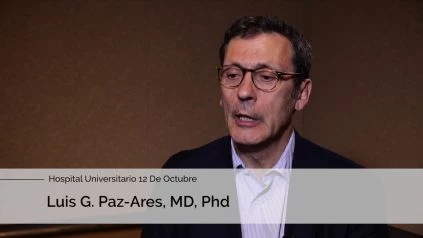Dr. Luis Paz-Ares, MD, Phd of the Hospital Universitario 12 De Octubre gives a brief overview of his ASCO 2019 presentation in Spanish entitled Efficacy and safety profile of lurbinectedin in second-line SCLC patients: Results from a phase II single-agent trial.
Abstract:
Background: Lurbinectedin (L) is a novel anticancer drug that inhibits activated transcription and induces DNA double-strand breaks, leading to apoptosis. Methods: A multicenter phase 2 basket trial assessed the efficacy and safety of L in several cancer types, including small cell lung cancer (SCLC). Primary endpoint was confirmed overall response rate (ORR) by RECIST v.1.1. In the SCLC cohort, a target ORR ?30% was set. One-hundred and five patients (pts) with ECOG PS 0-2 who had received one prior chemotherapy line were treated with L 3.2 mg/m2 as a 1-hour i.v. infusion on Day 1 q3wk. Results: Median age was 60 years (range, 40-83), 60% were male, ECOG PS 0/1/2 (32%/62%/6%), liver metastasis 41%, history of CNS involvement 3.8%, prior platinum 100%, median chemotherapy-free interval (CTFI): 3.5 (0-16.1) months; prior immunotherapy (IO): 7.6%. Pts received a median of 4 cycles (range, 1-24). Conclusions: L monotherapy is active in second-line SCLC in both resistant and sensitive disease. The acceptable and manageable safety profile is also associated to a convenient treatment administration (Day 1 q3wk). L as second-line treatment in SCLC emerges as a new promising drug for this unmet clinical need. Clinical trial information: NCT02454972
Overall
(n=105) CTFI<90d
(resistant disease)
(n=47) CTFI?90d
(sensitive disease)
(n=58)
ORR, % (95% CI) (confirmed responses) 35.2 (26.2-45.2)* 21.3 (10.7-35.7) 46.6 (33.3-60.1)
Disease Control Rate (%) at 8 wks 64.8 46.8 79.3
Median DOR (months) (95% CI) 5.3 (3.5-6.4) 4.7 (2.6-5.6) 6.2 (3.4-6.9)
DOR rate at 6 months (95% CI) % 40.3 11.7 50.3
DOR rate at 12 months (95% CI) % 10.6 – 14.7
Median OS (months) (95% CI) ^ 10.8 (6.5-12.2) 5.1 (4.4-8.1) 15.2 (10.2-16.2)
* 5 of 8 pts who failed prior IO had confirmed response DOR: duration of response; ^ Preliminary Myelosuppression was the most common adverse event (AE): G3 (22%) and G4 (23.8%) neutropenia, G3/4 febrile neutropenia (3.8%) and G3/4 thrombocytopenia (6.6%). Secondary prophylaxis or therapeutic G-CSF was given in 15.2%. Most common non-hematological AEs were fatigue (G3: 4.8%), nausea and vomiting (all G1/2). Related serious AEs occurred in 10.5% pts, while treatment-related discontinuations in 3.8%. No treatment-related deaths were reported.

